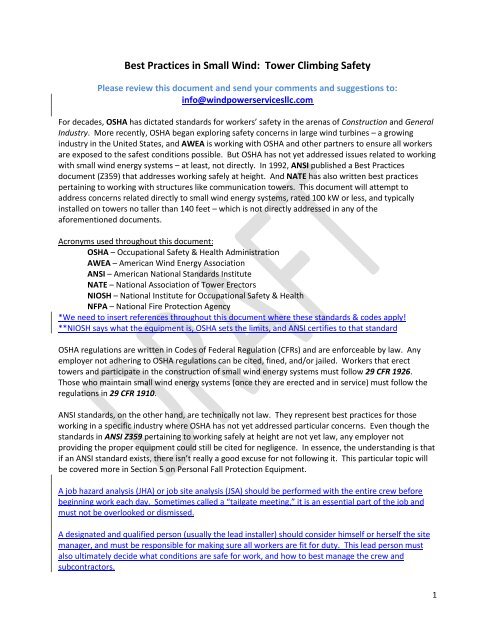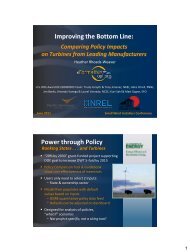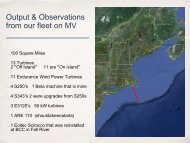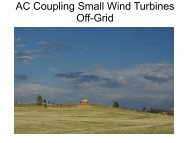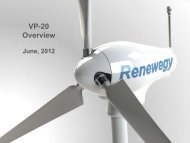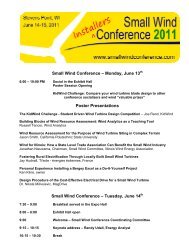Best Practices in Small Wind: Tower Climbing Safety
Best Practices in Small Wind: Tower Climbing Safety
Best Practices in Small Wind: Tower Climbing Safety
Create successful ePaper yourself
Turn your PDF publications into a flip-book with our unique Google optimized e-Paper software.
<strong>Best</strong> <strong>Practices</strong> <strong>in</strong> <strong>Small</strong> W<strong>in</strong>d: <strong>Tower</strong> Climb<strong>in</strong>g <strong>Safety</strong><br />
Please review this document and send your comments and suggestions to:<br />
<strong>in</strong>fo@w<strong>in</strong>dpowerservicesllc.com<br />
For decades, OSHA has dictated standards for workers’ safety <strong>in</strong> the arenas of Construction and General<br />
Industry. More recently, OSHA began explor<strong>in</strong>g safety concerns <strong>in</strong> large w<strong>in</strong>d turb<strong>in</strong>es – a grow<strong>in</strong>g<br />
<strong>in</strong>dustry <strong>in</strong> the United States, and AWEA is work<strong>in</strong>g with OSHA and other partners to ensure all workers<br />
are exposed to the safest conditions possible. But OSHA has not yet addressed issues related to work<strong>in</strong>g<br />
with small w<strong>in</strong>d energy systems – at least, not directly. In 1992, ANSI published a <strong>Best</strong> <strong>Practices</strong><br />
document (Z359) that addresses work<strong>in</strong>g safely at height. And NATE has also written best practices<br />
perta<strong>in</strong><strong>in</strong>g to work<strong>in</strong>g with structures like communication towers. This document will attempt to<br />
address concerns related directly to small w<strong>in</strong>d energy systems, rated 100 kW or less, and typically<br />
<strong>in</strong>stalled on towers no taller than 140 feet – which is not directly addressed <strong>in</strong> any of the<br />
aforementioned documents.<br />
Acronyms used throughout this document:<br />
OSHA – Occupational <strong>Safety</strong> & Health Adm<strong>in</strong>istration<br />
AWEA – American W<strong>in</strong>d Energy Association<br />
ANSI – American National Standards Institute<br />
NATE – National Association of <strong>Tower</strong> Erectors<br />
NIOSH – National Institute for Occupational <strong>Safety</strong> & Health<br />
NFPA – National Fire Protection Agency<br />
*We need to <strong>in</strong>sert references throughout this document where these standards & codes apply!<br />
**NIOSH says what the equipment is, OSHA sets the limits, and ANSI certifies to that standard<br />
OSHA regulations are written <strong>in</strong> Codes of Federal Regulation (CFRs) and are enforceable by law. Any<br />
employer not adher<strong>in</strong>g to OSHA regulations can be cited, f<strong>in</strong>ed, and/or jailed. Workers that erect<br />
towers and participate <strong>in</strong> the construction of small w<strong>in</strong>d energy systems must follow 29 CFR 1926.<br />
Those who ma<strong>in</strong>ta<strong>in</strong> small w<strong>in</strong>d energy systems (once they are erected and <strong>in</strong> service) must follow the<br />
regulations <strong>in</strong> 29 CFR 1910.<br />
ANSI standards, on the other hand, are technically not law. They represent best practices for those<br />
work<strong>in</strong>g <strong>in</strong> a specific <strong>in</strong>dustry where OSHA has not yet addressed particular concerns. Even though the<br />
standards <strong>in</strong> ANSI Z359 perta<strong>in</strong><strong>in</strong>g to work<strong>in</strong>g safely at height are not yet law, any employer not<br />
provid<strong>in</strong>g the proper equipment could still be cited for negligence. In essence, the understand<strong>in</strong>g is that<br />
if an ANSI standard exists, there isn’t really a good excuse for not follow<strong>in</strong>g it. This particular topic will<br />
be covered more <strong>in</strong> Section 5 on Personal Fall Protection Equipment.<br />
A job hazard analysis (JHA) or job site analysis (JSA) should be performed with the entire crew before<br />
beg<strong>in</strong>n<strong>in</strong>g work each day. Sometimes called a “tailgate meet<strong>in</strong>g,” it is an essential part of the job and<br />
must not be overlooked or dismissed.<br />
A designated and qualified person (usually the lead <strong>in</strong>staller) should consider himself or herself the site<br />
manager, and must be responsible for mak<strong>in</strong>g sure all workers are fit for duty. This lead person must<br />
also ultimately decide what conditions are safe for work, and how to best manage the crew and<br />
subcontractors.<br />
1
This <strong>Best</strong> <strong>Practices</strong> document is a work-<strong>in</strong>-progress, and was complied with <strong>in</strong>put from a number of<br />
small w<strong>in</strong>d energy <strong>in</strong>stallers and tower climb<strong>in</strong>g professionals, <strong>in</strong>clud<strong>in</strong>g:<br />
Roy Butler, Four W<strong>in</strong>ds Renewable Energy (NY)<br />
Lisa DiFrancisco, North Coast Energy Systems (PA)<br />
Roger Dixon, Skylands Renewable Energy (NJ)<br />
Jenny He<strong>in</strong>zen, Midwest Renewable Energy Association (WI)<br />
Brandon Naylor, <strong>Tower</strong> Technologies (WI)<br />
Mick Sagrillo, Sagrillo Power & Light (WI)<br />
Tristan Shell-Spurl<strong>in</strong>g, <strong>Tower</strong> Top Energy (OR)<br />
Tammy Stoner, W<strong>in</strong>d Power Services (MI)<br />
Donny Davol, Ethos Distributed Energy (CO)<br />
Troy Hewitt, Intertek (NY)<br />
Brent Hrywkiw, Wes<strong>Tower</strong> (CA)<br />
Joe DiFrancisco, North Coast Energy Systems (PA)<br />
Gary Harcourt, Great Rock W<strong>in</strong>dpower (MA)<br />
David Briggs, Clean Energy Center (NV)<br />
Norman Atwood, Atwood Electric, Inc. (IA)<br />
Jim Norman, ABS Alaskan, Inc. (AK)<br />
Randy Richmond, RightHand Eng<strong>in</strong>eer<strong>in</strong>g, LLC (WA)<br />
Table of Contents<br />
1. Environmental Hazards Pages 3-8<br />
2. Job Site Hazards Pages 9-11<br />
3. Personal Protective Equipment (PPE) Page 12<br />
4. Personal Fall Protection Equipment (PFPE) Pages 13-17<br />
5. Emergency & Rescue Plann<strong>in</strong>g Pages 18-20<br />
6. Health & Fitness Page 21<br />
7. <strong>Tower</strong> & Foundation Inspection Pages 22-24<br />
8. Ground Crew Page<br />
8.9. Work<strong>in</strong>g with Cranes Pages 25-30<br />
Appendix A: Understand<strong>in</strong>g Z359 (Miller)<br />
Appendix B:<br />
Appendix C:<br />
Disclaimer:<br />
All images <strong>in</strong> this document have not yet been copyright approved. This is only a draft. Pictures<br />
selected for this draft document are only for clarification purposes and flow.<br />
2
WEATHER<br />
Section 1: Environmental Hazards<br />
� Extreme Heat:<br />
Follow reasonable and practicable NIOSH recommendations and make sure all workers are<br />
tra<strong>in</strong>ed to recognize the signs of heat exhaustion and heat stroke. Note that metal surfaces<br />
exposed to direct sunlight may be hot enough to cause sk<strong>in</strong> burns.<br />
<strong>Best</strong> practices for work<strong>in</strong>g <strong>in</strong> extreme heat:<br />
� Dr<strong>in</strong>k plenty of water; stay hydrated<br />
� Take breaks as needed<br />
� Avoid heavy foods<br />
� Dress <strong>in</strong> light, breathable cloth<strong>in</strong>g<br />
� Use sunscreen, sunglasses, and lip balm when work<strong>in</strong>g <strong>in</strong> direct sunlight<br />
� Ingest salt tabs or electrolytes for extreme or excessive sweat<strong>in</strong>g<br />
� Avoid work<strong>in</strong>g <strong>in</strong> the extreme heat; if practicable, rearrange climb<strong>in</strong>g schedule<br />
� Know your limits. Acclimated workers are better suited to work <strong>in</strong> extreme heat.<br />
� Extreme Cold:<br />
Follow reasonable and practicable NIOSH recommendations and make sure all workers are<br />
tra<strong>in</strong>ed to recognize the signs of hypothermia and frostbite. Note that extremely cold air also<br />
tends to be extremely dry air. Dehydration, w<strong>in</strong>d burn and even sunburn can occur rapidly <strong>in</strong><br />
cold weather.<br />
<strong>Best</strong> practices for work<strong>in</strong>g <strong>in</strong> extreme cold:<br />
� Dr<strong>in</strong>k plenty of water; stay hydrated. Warm fluids can provide energy, warmth and<br />
replace fluids lost dur<strong>in</strong>g work, but care should be taken to prevent overconsumption<br />
of caffe<strong>in</strong>e.<br />
� Dress <strong>in</strong> many th<strong>in</strong>, light layers <strong>in</strong>stead of s<strong>in</strong>gle-layer, bulky clothes<br />
� Keep your head covered with a hat to avoid heat loss<br />
� Avoid excessive sweat<strong>in</strong>g & stay dry<br />
� Use hand-warmers, boot-warmers, and/or portable heaters if necessary<br />
� Have gloves with good grip for climb<strong>in</strong>g, and br<strong>in</strong>g mittens or thick gloves for<br />
keep<strong>in</strong>g f<strong>in</strong>gers warm when not climb<strong>in</strong>g<br />
� Have extra dry clothes, gloves, and blankets available at the job site<br />
� Sunglasses are recommended when sunlight is reflect<strong>in</strong>g on ice and snow<br />
� Use lip balm, sunscreen or petroleum jelly to protect face aga<strong>in</strong>st w<strong>in</strong>d/sunburn<br />
� Know your limits. Acclimated workers are better suited to work <strong>in</strong> extreme cold.<br />
� Ra<strong>in</strong> and Dew (Moisture):<br />
Climb<strong>in</strong>g <strong>in</strong>side of a monopole structure is not as risky as climb<strong>in</strong>g on an exposed tower <strong>in</strong> the<br />
ra<strong>in</strong>. Surfaces can become very slick, and for that reason, climb<strong>in</strong>g a wet structure is highly<br />
discouraged.<br />
<strong>Best</strong> practice: Never climb a wet tower<br />
3
� Mud:<br />
Along with precipitation comes muddy ground. Mud poses hazards such as: difficult to<br />
maneuver (or stuck) mach<strong>in</strong>ery, unstable holes and trenches, and dangerous climb<strong>in</strong>g<br />
conditions.<br />
<strong>Best</strong> practices:<br />
� Take measures to m<strong>in</strong>imize mud at and around the tower base to keep muddy work<br />
boots off the tower<br />
� Wear “mud boots” to the work site, then change <strong>in</strong>to clean, dry boots <strong>in</strong> the clean<br />
area ma<strong>in</strong>ta<strong>in</strong>ed at the tower base before climb<strong>in</strong>g<br />
� Ice and Snow:<br />
Structures covered <strong>in</strong> ice are dangerous, as they are of course quite slippery. Additionally,<br />
sections of ice may fall to the ground and may be hazardous to people and property.<br />
<strong>Best</strong> practices:<br />
� Never approach an icy tower<br />
� Never climb an icy or snow covered tower<br />
� Wait for ice to melt before attempt<strong>in</strong>g to restart a w<strong>in</strong>d energy system<br />
� Keep vehicles parked upw<strong>in</strong>d of the tower and out of the ice and snow “ shed zone,”<br />
or approximately one half the tower height – where the ice would most likely land<br />
� Lightn<strong>in</strong>g:<br />
Work<strong>in</strong>g on tall towers and be<strong>in</strong>g <strong>in</strong> close proximity to metal structures and electrical equipment<br />
poses particular concerns dur<strong>in</strong>g thunderstorms or lightn<strong>in</strong>g events. Refer to the National<br />
Lightn<strong>in</strong>g <strong>Safety</strong> Institute for more <strong>in</strong>formation and decision trees. (http://lightn<strong>in</strong>gsafety.com)<br />
<strong>Best</strong> practices for storms and lightn<strong>in</strong>g:<br />
� Get off the tower if you hear thunder or see lightn<strong>in</strong>g<br />
� Stay a reasonable distance away from the tower dur<strong>in</strong>g lightn<strong>in</strong>g or thunderstorms<br />
� Cont<strong>in</strong>ually monitor the local weather radar for storm watches and warn<strong>in</strong>gs<br />
� Ma<strong>in</strong>ta<strong>in</strong> cont<strong>in</strong>uous communication between all members of the tower and ground<br />
crews, especially when there is an <strong>in</strong>creased potential (“watch”) for severe weather<br />
� Seek shelter <strong>in</strong>side a vehicle or build<strong>in</strong>g, and away from trees, tall structures, and metal<br />
equipment dur<strong>in</strong>g a storm<br />
� Excessive W<strong>in</strong>d:<br />
It’s ironic, but it’s dangerous to work on a w<strong>in</strong>d turb<strong>in</strong>e <strong>in</strong> high w<strong>in</strong>ds. Many crane operators are<br />
hesitant to lift when w<strong>in</strong>d speeds are over 25 mph. Ropes can easily get tangled <strong>in</strong> tower<br />
structure and guy wires. Work<strong>in</strong>g <strong>in</strong> high w<strong>in</strong>ds tires climbers more quickly, so accidents are<br />
more likely to happen – and rescues or evacuations will be more difficult to execute.<br />
Communication becomes difficult <strong>in</strong> high w<strong>in</strong>ds, as typically the only noise one can hear on a<br />
radio or phone is the whistl<strong>in</strong>g of the w<strong>in</strong>d, and shout<strong>in</strong>g isn’t a good option. Note that high<br />
w<strong>in</strong>ds comb<strong>in</strong>ed with cold temperatures can result <strong>in</strong> w<strong>in</strong>d chill advisories and warn<strong>in</strong>gs. Crews<br />
should assess the tasks at hand, as there is a vary<strong>in</strong>g scale of work that can be done – depend<strong>in</strong>g<br />
upon the competence and experience of each worker.<br />
4
<strong>Best</strong> practices for work<strong>in</strong>g <strong>in</strong> high w<strong>in</strong>ds:<br />
� Avoid climb<strong>in</strong>g towers when w<strong>in</strong>d speeds are approach<strong>in</strong>g 25 mph or are extremely<br />
gusty. High w<strong>in</strong>ds have the potential to damage yaw and rotor locks, door covers, and<br />
other equipment and hardware on the tower.<br />
� Take precautions and measures to ensure ropes won’t get caught and tangled <strong>in</strong> the<br />
structure or with each other<br />
� Use a th<strong>in</strong> layer of petroleum jelly on the face & lips to avoid w<strong>in</strong>dburn<br />
� Cont<strong>in</strong>ually monitor local weather stations for watches and warn<strong>in</strong>gs<br />
5
ANIMALS & INSECTS<br />
Critters can bite and st<strong>in</strong>g. An encounter can be a mild <strong>in</strong>convenience or a life-threaten<strong>in</strong>g situation.<br />
Those allergic to bees or other <strong>in</strong>sects can go <strong>in</strong>to anaphylactic shock, requir<strong>in</strong>g immediate medical<br />
attention. Less dramatic but nonetheless a hazard, bird dropp<strong>in</strong>gs on climb<strong>in</strong>g surfaces are slippery – so<br />
watch out for them.<br />
<strong>Best</strong> practices:<br />
� All workers should be tra<strong>in</strong>ed <strong>in</strong> First Aid, and a standard First Aid kit should be on the job site.<br />
Note that First Aid kits don’t typically conta<strong>in</strong> EpiPens for st<strong>in</strong>gs, as they are sensitive to time<br />
and temperature.<br />
� Anyone with a known allergy should br<strong>in</strong>g with him or her the medication needed <strong>in</strong> case of an<br />
emergency, and all workers should know the exact location of the medication and how to<br />
adm<strong>in</strong>ister it<br />
� All workers should know the location of the nearest hospital emergency room<br />
� Workers should carry cell phones so that 911 can be called <strong>in</strong> case of an emergency<br />
� Be cautious when approach<strong>in</strong>g holes, enclosures, or otherwise sheltered areas – as they may<br />
conta<strong>in</strong> animals or <strong>in</strong>sects (especially wasps) ready to defend their home. When <strong>in</strong> doubt, use a<br />
stick or tool to reach <strong>in</strong> first or tap the cover.<br />
� Always close covers and plug holes on all applicable equipment to discourage <strong>in</strong>festation<br />
� Be aware of potential nest<strong>in</strong>g and hid<strong>in</strong>g spots for snakes, birds, rodents, and small mammals<br />
� Always be aware of potentially dangerous wildlife (bears, moose, cats) on the worksite –<br />
depend<strong>in</strong>g, of course, upon your geographical location. Talk to the customers and the locals,<br />
and heed posted warn<strong>in</strong>gs.<br />
� Insect repellant can make the difference between a tolerable and a miserable day on the work<br />
site. <strong>Best</strong> practice is to keep it seasonally available for crew members.<br />
WORK AT NIGHT<br />
Work<strong>in</strong>g at night and <strong>in</strong> the dark morn<strong>in</strong>g hours can have its own hazards. Gett<strong>in</strong>g to the job site early<br />
and leav<strong>in</strong>g late can have detrimental effects on crew members and leaders. The push to complete a<br />
job <strong>in</strong> a timely manner can lead to long hours, and this can affect the decision mak<strong>in</strong>g abilities of crew<br />
members. At night, excavated holes, tower step bolts, and other hazards “disappear,” mak<strong>in</strong>g even<br />
walk<strong>in</strong>g through a site hazardous to all. For this reason, work<strong>in</strong>g at night or <strong>in</strong> the dark morn<strong>in</strong>g hours is<br />
discouraged.<br />
<strong>Best</strong> practices:<br />
� Plan all work days to start when there is enough light to see the job site and on-site hazards<br />
clearly<br />
� Plan all work days to end before dark. (This <strong>in</strong>cludes any housekeep<strong>in</strong>g or site clean-up<br />
activities.)<br />
� If work<strong>in</strong>g on a tower when dusk is approach<strong>in</strong>g, beg<strong>in</strong> descend<strong>in</strong>g the tower at least one half<br />
hour before it becomes difficult to see. This should allow enough time to address “typical” or<br />
unexpected problems on the way down the tower.<br />
8
� If work must cont<strong>in</strong>ue after dark, be sure all crew members have hands-free light<strong>in</strong>g (head<br />
lamps and flood lights) and all major hazards are flagged with reflective material that can be<br />
seen from all angles of approach.<br />
EXAMPLE: PROPER LIGHTING FOR GROUND WORK AT NIGHT<br />
HUNTERS & RECREATIONAL SHOOTERS<br />
Be aware of hunters and recreational gun users. Avoid camouflage outerwear dur<strong>in</strong>g hunt<strong>in</strong>g seasons;<br />
wear bright colors (like blaze orange or high-visibility green) so you are easily seen and not accidentally<br />
mistaken for game. Pay particular attention and report to the customer and the authorities if you see<br />
bullet holes <strong>in</strong> the nacelle or evidence that someone has shot at the tower.<br />
9
Section 2: Job Site Hazards<br />
What about communication or other equipment on the tower? Climb<strong>in</strong>g around other stuff… antennas<br />
Before beg<strong>in</strong>n<strong>in</strong>g any job, the crew must perform an assessment of the hazards on the site and the risks<br />
associated with the work. This is often referred to as a Job <strong>Safety</strong> Analysis (JSA) or Hazard Identification,<br />
Risk Assessment and Control (HIRAC). The JSA/HIRAC is a written document that shows due diligence on<br />
behalf of the employer to m<strong>in</strong>imize risks, and can serve as a “checklist” for the tower crew before<br />
commenc<strong>in</strong>g work.<br />
COMMON HAZARDS IN SMALL WIND<br />
� Construction Equipment:<br />
Often, especially dur<strong>in</strong>g the erection of a tower, construction vehicles will be on the premises.<br />
Forklifts, front end loaders, cranes, and other equipment can present hazards to the crew. Stay<br />
alert and aware of your surround<strong>in</strong>gs, especially these large pieces of equipment.<br />
<strong>Best</strong> <strong>Practices</strong>:<br />
� Only tra<strong>in</strong>ed and qualified personnel should operate construction equipment<br />
� Crew members should wear high visibility clothes when work<strong>in</strong>g with or near construction<br />
equipment, especially cranes<br />
� Have a predeterm<strong>in</strong>ed method of communication between equipment operators and crew<br />
members<br />
� Mechanical Equipment:<br />
<strong>Small</strong> w<strong>in</strong>d turb<strong>in</strong>es are electromechanical systems that use and/or produce electricity and have<br />
many mov<strong>in</strong>g parts. Special care must be taken to stay safe when work<strong>in</strong>g with or near these<br />
systems. Pay special attention to the shutdown procedures specified by the manufacturer.<br />
Potential hazards <strong>in</strong>clude:<br />
� Rotat<strong>in</strong>g equipment<br />
� P<strong>in</strong>ch po<strong>in</strong>ts<br />
� Spr<strong>in</strong>gs under tension<br />
� Hydraulic and pneumatic systems<br />
� Yaw mechanisms<br />
<strong>Best</strong> practices:<br />
� Never climb a tower when the turb<strong>in</strong>e is runn<strong>in</strong>g or sp<strong>in</strong>n<strong>in</strong>g<br />
� Never try to “catch” a runaway rotor on the tower<br />
� If necessary and appropriate, use ropes or straps to secure the rotor to the nacelle<br />
� Never secure the rotor directly to the tower, as blade damage is likely to occur if the<br />
mach<strong>in</strong>e yaws<br />
� Follow yaw lock procedures, if the mach<strong>in</strong>e has a yaw lock mechanism. If the mach<strong>in</strong>e<br />
doesn’t have a yaw lock, use necessary precautions (like ropes, straps and knots) to ensure<br />
that the rotor will not yaw if the w<strong>in</strong>d switches direction.<br />
Be aware of hydraulic and/or pneumatic l<strong>in</strong>es and fitt<strong>in</strong>gs that may be under pressure <strong>in</strong> the<br />
nacelle as part of the brake or yaw system<br />
10
� Make sure your lanyards and work position<strong>in</strong>g belts are not tangled <strong>in</strong> mov<strong>in</strong>g equipment or<br />
<strong>in</strong> a place that damages w<strong>in</strong>d turb<strong>in</strong>e equipment or damages the PFPE (sharp<br />
edges/grease/crane lift<strong>in</strong>g po<strong>in</strong>ts, etc.)<br />
� Electrical Equipment:<br />
Electricity can be dangerous. Voltage, or difference <strong>in</strong> electrical potential, is responsible for<br />
deliver<strong>in</strong>g electrical shocks. If the human body receives a shock and current is present, it can<br />
cause serious <strong>in</strong>juries and even death. For that reason, only qualified and tra<strong>in</strong>ed personnel<br />
should work on electrical equipment.<br />
NFPA 70E (Arc Flash safe practices) dictates that any voltage over 50 volts is considered<br />
dangerous and requires appropriate Personal Protective Equipment. Fire retardant cloth<strong>in</strong>g,<br />
gloves, and face shields may be necessary for particular electrical tasks. Therefore, anyone not<br />
qualified should not open live electrical enclosures or cab<strong>in</strong>ets.<br />
All climbers should practice “Lockout/Tagout” before climb<strong>in</strong>g any tower – <strong>in</strong>stall<strong>in</strong>g (a) pad<br />
lock(s) on electrical disconnects and power sources whenever practicable. A separate padlock<br />
should be used by each worker, and only one key should be <strong>in</strong> circulation for each lock. Per<br />
OSHA regulations, only he or she who applied the lock shall be allowed to remove it. (Note that<br />
there are certa<strong>in</strong> conditions that require power be present to test, troubleshoot, or reposition<br />
the mach<strong>in</strong>e – but when such maneuvers are not underway, the system should be de-energized<br />
and put <strong>in</strong>to an electrically safe work<strong>in</strong>g condition.)<br />
<strong>Best</strong> <strong>Practices</strong>:<br />
� Each employee should be assigned his or her own personal lock and key<br />
� A padlock should be accompanied with a tag with the name of the person who <strong>in</strong>stalled the<br />
lock<br />
� Each crew should carry a multi-lock device (hasp) so all workers can attach their locks and<br />
tags on one disconnect switch or control cab<strong>in</strong>et<br />
� Each crew should have available arc flash rated equipment and tools if electrical exposure is<br />
expected and/or typical<br />
� Only qualified and tra<strong>in</strong>ed personnel shall perform electrical work<br />
PADLOCK AND KEY MULTIPLE-LOCK DEVICE (HASP) TAG (FRONT AND BACK)<br />
11
� Fall<strong>in</strong>g Objects:<br />
Work<strong>in</strong>g under a tower, especially with climbers above, can be hazardous. Two or more<br />
climbers work<strong>in</strong>g at different heights can also be risky. Efforts should be made to avoid work<strong>in</strong>g<br />
directly below other climbers. Note that dropped tools or equipment can also ricochet off a<br />
tower section and alter the path of descent. Never <strong>in</strong>tentionally drop or throw anyth<strong>in</strong>g off a<br />
tower.<br />
<strong>Best</strong> practices:<br />
� Hardhats or helmets are required at all times for climbers and ground crew<br />
� Avoid work<strong>in</strong>g directly under the tower when climbers are on the tower<br />
� Establish a work zone under the tower equal to half the total height, the distance that<br />
tools or hardware could fall away from and/or ricochet off the tower<br />
� Establish “exclusion zones” of at least twice the height for onlookers and media<br />
� Climbers should only use buckets, pouches, bags and pockets for tools, parts, and<br />
hardware that can be closed, zipped, fastened, or otherwise securely closed<br />
� Use tools and gear fitted with loops or sl<strong>in</strong>gs so they can be secured with carab<strong>in</strong>ers to<br />
the climber, or to the tower<br />
� Keep vehicles parked at least one-half the tower height away from the base of the tower<br />
to avoid damage from accidentally dropped tools or equipment<br />
� All haul ropes should be the proper strength and diameter for tools to be used<br />
� Adequate and proper pulley systems and anchor po<strong>in</strong>ts are essential for lift<strong>in</strong>g and<br />
haul<strong>in</strong>g. Progressive capture for rope systems is highly encouraged.<br />
� Tag l<strong>in</strong>es (what about them??)<br />
� Pay attention to weight restrictions for tools and buckets, and use mechanical<br />
advantage wherever possible<br />
� Have a code word understood by the entire crew before work beg<strong>in</strong>s like “HEADACHE!”<br />
that will alert a crew members someth<strong>in</strong>g has been accidentally dropped and evasive<br />
maneuvers (runn<strong>in</strong>g, duck<strong>in</strong>g or hid<strong>in</strong>g) are immediately necessary.<br />
� Communication:<br />
Climbers and the ground crew need to stay <strong>in</strong> contact with each other. Work<strong>in</strong>g with each<br />
other, yet separated by distance, can be hazardous if there is difficulty communicat<strong>in</strong>g what’s<br />
happen<strong>in</strong>g at each end. The w<strong>in</strong>dier it gets, the harder it is to communicate by shout<strong>in</strong>g. Yell<strong>in</strong>g<br />
is not the recommended method for stay<strong>in</strong>g <strong>in</strong> contact with coworkers.<br />
<strong>Best</strong> practices:<br />
� Keep radios or “walkie-talkies” charged and available at the job site<br />
� Carry cell phones for alternate means of communication, and make sure they are<br />
charged<br />
� Those work<strong>in</strong>g up-tower are generally “<strong>in</strong> charge” and should direct the ground crew.<br />
Work<strong>in</strong>g on the ground does not offer the same perspective as someone on the tower,<br />
where there are generally more hazards and greater risks.<br />
� Use hand signals (crane signals agreed upon by the crane operator and crew before<br />
work beg<strong>in</strong>s) when your hands are full, if the radios aren’t function<strong>in</strong>g properly, or you<br />
cannot hear well with other means of communication.<br />
� When us<strong>in</strong>g radios, do not use foul language. Have a system and language agreed upon<br />
by the entire crew before work beg<strong>in</strong>s. Standard words and phrases like “copy that”<br />
and “over” are encouraged for clarity dur<strong>in</strong>g tower work.<br />
12
Section 3: Personal Protective Equipment (PPE)<br />
Like any other skilled trade, tower climb<strong>in</strong>g requires the use of personal protective equipment for nearly<br />
all tasks. Workers must protect their eyes, ears, head, hands, and feet.<br />
� Eyes: <strong>Safety</strong> glasses, approved eyeglasses, or sunglasses shall be worn at all times. (OSHA<br />
reference) Goggles are recommended <strong>in</strong> cold and w<strong>in</strong>dy weather.<br />
� Ears: Hear<strong>in</strong>g protection shall be worn when decibel levels exceed OSHA limits (e.g., us<strong>in</strong>g loud<br />
power tools or bang<strong>in</strong>g on tower structure) (OSHA reference)<br />
� Head: Helmets or hardhats shall be worn at all times when approach<strong>in</strong>g and/or work<strong>in</strong>g on a<br />
tower. (OSHA reference)<br />
� Ch<strong>in</strong> straps on helmets are recommended to stop the helmet from fall<strong>in</strong>g off the<br />
worker’s head.<br />
� Helmets shall be top- and side-impact rated for climbers. (ANSI reference) Top-impactonly<br />
rated hardhats are permitted for ground crew members.<br />
� Helmets shall not be vented if electrical and/or chemical work is typical or rout<strong>in</strong>e (ANSI<br />
reference)<br />
� Hands: Gloves are highly recommended whenever practicable because work<strong>in</strong>g on a metal<br />
structure and with ropes has the potential to severely damage the hands. Additionally, foot<br />
pegs and ladder rungs are sometimes manufactured or coated with abrasive grips. See Section<br />
1 on Environmental Hazards regard<strong>in</strong>g protection of the hands <strong>in</strong> cold temperatures.<br />
� Feet: Closed-toed shoes are required. Leather, waterproof work boots with ankle support and<br />
soles with good grip are recommended. Steel toes are not typically required, s<strong>in</strong>ce they can be<br />
cumbersome when climb<strong>in</strong>g a structure. However, they may be required or recommended by<br />
some employers. If work<strong>in</strong>g with electricity or <strong>in</strong> cold temperatures, composite toes are<br />
recommended <strong>in</strong>stead of steel toes. Steel shanks are recommended if stand<strong>in</strong>g on th<strong>in</strong> metal<br />
structures for long periods of time is typical or rout<strong>in</strong>e<br />
� Arc Flash Equipment: Whenever a worker is exposed to 50 volts or more, he or she must be<br />
tra<strong>in</strong>ed <strong>in</strong> arc flash requirements and wear appropriate Personal Protective Equipment. See<br />
NFPA 70E for more <strong>in</strong>formation regard<strong>in</strong>g arc flash requirements <strong>in</strong>clud<strong>in</strong>g:<br />
� Cotton cloth<strong>in</strong>g and long sleeves<br />
� Gloves, face shields, and flash suits<br />
� Insulated tools<br />
� Qualified persons and required tra<strong>in</strong><strong>in</strong>g<br />
EXAMPLE: ARC FLASH EQUIPMENT<br />
13
Section 4: Personal Fall Protection Equipment (PFPE)<br />
In OSHA 29 CFR 1926 (Construction), a worker is required to be <strong>in</strong> full fall protection gear when work<strong>in</strong>g<br />
more than 6 feet off the ground. In 29 CFR 1910 (General Industry), work at 4 feet or higher requires fall<br />
protection. To be safe (and consistent), the best practice is to be <strong>in</strong> complete fall arrest gear when<br />
work<strong>in</strong>g 4 feet off the ground.<br />
OSHA Requirements: (<strong>in</strong>sert references)<br />
� A worker shall never be exposed to more than a 6 foot free fall<br />
� A full body harness shall be used; l<strong>in</strong>eman, arborist, or other climb<strong>in</strong>g “belts” are not acceptable<br />
� Tw<strong>in</strong> arm lanyards or two s<strong>in</strong>gle lanyards shall be attached to the back D-r<strong>in</strong>g of the full body<br />
harness. When not <strong>in</strong> use, these lanyards are stored on the climber’s side D-r<strong>in</strong>gs.<br />
� Energy absorbers <strong>in</strong> the tw<strong>in</strong> arm lanyards should limit the forces on the body to 1800 pounds <strong>in</strong><br />
the event of a fall<br />
� Climbers shall always be “100% tied off” to the tower or a safe climb system. Never shall a<br />
worker be without fall protection. Absolutely no “free climb<strong>in</strong>g” is allowed.<br />
� Anchor po<strong>in</strong>ts used for personal fall arrest systems shall be capable of hold<strong>in</strong>g 5000 pounds.<br />
(Ask yourself – Would this anchor po<strong>in</strong>t support a full-size pick-up truck?)<br />
� Work position<strong>in</strong>g belts, when used, must be <strong>in</strong> conjunction with fall arrest. Work position<strong>in</strong>g<br />
lanyards are not part of a personal fall arrest system.<br />
ANSI Z359 Standards: (<strong>in</strong>sert references)<br />
� Fall Factor 1 tw<strong>in</strong> arm lanyards should be used when attach<strong>in</strong>g to an anchor po<strong>in</strong>t at or above<br />
the rear D-r<strong>in</strong>g of the harness, and should limit the forces on the body to 900 pounds<br />
� Fall Factor 2 tw<strong>in</strong> arm lanyards should be used when attach<strong>in</strong>g to an anchor po<strong>in</strong>t below the<br />
rear D-r<strong>in</strong>g of the harness, and should limit the forces on the body to 1350 pounds<br />
� Lanyards will deploy properly when the total weight of the person <strong>in</strong> the harness (with all<br />
equipment and tools) is between 130 and 310 pounds<br />
� These ANSI standards are the reason why climbers no longer use straight-nylon or rope-type<br />
lanyards with no Personal Energy Absorber. The forces generated dur<strong>in</strong>g a fall without a PEA<br />
would likely exceed the OSHA-mandated 1800 pound maximum and cause serious harm.<br />
� Local codes & restrictions (CA – 4’ lanyards)<br />
Tw<strong>in</strong> Arm Lanyards Tw<strong>in</strong> Arm Lanyards without PEA<br />
With Personal Energy Absorber (PEA) VIOLATION:<br />
Fall Factor 1 = 900 lb max force on body May not limit max force on body to 1800 lb<br />
Fall Factor 2 = 1350 lb max force on body<br />
14
We need to add calculat<strong>in</strong>g total fall distances!<br />
Lanyards deploy (FF1/2 – harness stretch, etc…)<br />
<strong>Best</strong> <strong>Practices</strong> with regard to PFPE:<br />
Equipment Inspections:<br />
� A complete fall arrest system must be used with every climb<br />
� Annual written and recorded <strong>in</strong>spections by qualified and competent and tra<strong>in</strong>ed workers are<br />
required. Each piece of PFPE <strong>in</strong>spected shall be appropriately marked on designated<br />
manufacturer tags, <strong>in</strong>clud<strong>in</strong>g the name or <strong>in</strong>itials of the <strong>in</strong>spector and the date.<br />
� Get a “buddy check” from a coworker before climb<strong>in</strong>g the tower and commenc<strong>in</strong>g work<br />
� Check all equipment for damage before each climb. Before each climb, look for:<br />
� Worn or frayed stitch<strong>in</strong>g<br />
� Cuts, rips, tears, burns, or mold<br />
� Discoloration (UV or chemical degradation)<br />
� Proper activation & seat<strong>in</strong>g of snap hooks and carab<strong>in</strong>ers<br />
� Signs of deployment (stitch<strong>in</strong>g/tags)<br />
� False connections (snap hooks accidentally connected to nylon from the harness, cloth<strong>in</strong>g,<br />
ropes, or other equipment)<br />
� Proper harness fit<br />
� Twists <strong>in</strong> the harness fabric<br />
� Proper placement of all equipment and tools<br />
Equipment Care & Storage:<br />
� Store all PFPE <strong>in</strong> a dry place, and out of direct sunlight<br />
� Never put wet equipment <strong>in</strong>to storage<br />
� Clean equipment as needed with water and mild soap. Air dry only; never use forced heat.<br />
Snap Hooks and Carab<strong>in</strong>ers:<br />
� Only use double- or triple-activation snap hooks and carab<strong>in</strong>ers. S<strong>in</strong>gle-action snap hooks can<br />
experience “roll-out” – especially when the hook is under pressure and not loaded along its<br />
major axis. (The gate on snap hooks and carab<strong>in</strong>ers are rated far less than along the major axis.)<br />
CARABINER SNAP HOOK SNAP HOOK<br />
(TRIPLE-ACTION) (TRIPLE-ACTION) (TRIPLE-ACTION)<br />
15
Components of a Personal Fall Arrest System:<br />
� Full Body Harness:<br />
The purpose of the harness is to catch a worker when he/she falls, keep the body <strong>in</strong> an upright<br />
position, and evenly distribute the hang<strong>in</strong>g weight. Waist bands or built-<strong>in</strong> “belts” are optional.<br />
The harness should have a m<strong>in</strong>imum of 4 D-r<strong>in</strong>gs:<br />
� Front (sternum) – for limited fall arrest (climb<strong>in</strong>g cable) systems<br />
� Back – for tw<strong>in</strong> arm lanyards<br />
� Sides (2) – for attach<strong>in</strong>g lanyard snap hooks when not <strong>in</strong> use, work position<strong>in</strong>g belts,<br />
tools, rope, and rescue equipment<br />
<strong>Best</strong> <strong>Practices</strong>:<br />
� The harness should fit well and be relatively snug – with only two f<strong>in</strong>gers of wiggle room<br />
between the leg straps and the body of the worker. If the harness is loose, it can<br />
seriously hurt the climber <strong>in</strong> the case of a fall (especially male climbers)<br />
� V-style harnesses are recommended for female climbers<br />
� One should have full range of motion while wear<strong>in</strong>g a full body harness. There are many<br />
styles harnesses available; the climber should wear what fits and works best.<br />
EXAMPLES: FULL BODY HARNESS (DBI SALA)<br />
16
� Tw<strong>in</strong> Arm Lanyards:<br />
Shock absorbers for the tw<strong>in</strong> arm lanyards will either be stitched directly <strong>in</strong>to the nylon of each<br />
arm (Partially Oriented Yarn – POY), or a s<strong>in</strong>gle Personal Energy Absorber (PEA) will be attached<br />
to the two static arms.<br />
EXAMPLES:<br />
S<strong>in</strong>gle lanyard with PEA (below) and<br />
Tw<strong>in</strong> arm lanyards with POY (right)<br />
Both styles are acceptable, and the lanyards will deploy properly if only ONE is attached and the<br />
total weight of the worker is between 130 and 310 pounds. Connect<strong>in</strong>g BOTH arms of a tw<strong>in</strong><br />
arm lanyard will result <strong>in</strong> only half the forces normally present dur<strong>in</strong>g a fall (s<strong>in</strong>ce the weight is<br />
evenly distributed between both arms), and the PEA may therefore not deploy as designed. This<br />
can result <strong>in</strong> excessive forces on the body.<br />
The exception to this rule is when a person is climb<strong>in</strong>g a structure by us<strong>in</strong>g tw<strong>in</strong> arm lanyards as<br />
fall protection. Remember the “100% tie off” rule – a worker can never be without fall<br />
protection. If a worker is climb<strong>in</strong>g a structure that does not have a safe climb (cable) system, he<br />
or she must attach the second arm of the lanyard before remov<strong>in</strong>g the first – and repeat this<br />
process all the way up and down the tower. While transition<strong>in</strong>g, it will be necessary to have<br />
both lanyards attached. When not <strong>in</strong> motion, the worker should have only one lanyard attached<br />
to an anchor po<strong>in</strong>t.<br />
Whenever possible, attach the lanyards directly above you – not off to the side. If a fall occurs,<br />
the climber will experience a “sw<strong>in</strong>g fall” and could susta<strong>in</strong> greater <strong>in</strong>juries by strik<strong>in</strong>g objects<br />
while sw<strong>in</strong>g<strong>in</strong>g.<br />
<strong>Best</strong> <strong>Practices</strong>:<br />
� Wear Fall Factor 1 lanyards when attach<strong>in</strong>g to anchor po<strong>in</strong>ts level with or above the<br />
back D-r<strong>in</strong>g of the harness<br />
� Wear Fall Factor 2 lanyards when attach<strong>in</strong>g to anchor po<strong>in</strong>ts below the back D-r<strong>in</strong>g of<br />
the harness<br />
� Keep lanyards connected directly above the body, not off to the side (whenever<br />
possible)<br />
� When not transition<strong>in</strong>g, have only one lanyard attached so PEA will properly deploy<br />
17
� Limited Fall Arrest Systems:<br />
Some small w<strong>in</strong>d energy system towers have a steel cable that allows the climber to ascend and<br />
descend the ladder or foot pegs without hav<strong>in</strong>g to use the tw<strong>in</strong> arm lanyards. When this is the<br />
case, a limited fall arrest system must be attached from the cable to the front D-r<strong>in</strong>g of the full<br />
body harness. The most common limited fall arrest systems <strong>in</strong> small w<strong>in</strong>d are the Lad-Saf® (DBI<br />
Sala®) and the Tuf-Tug®. Safe climb systems that use cables and limited fall arrest are highly<br />
recommended over the lanyard-by-lanyard process described <strong>in</strong> the previous section.<br />
Per ANSI Z359 standards, the maximum free fall distance allowed on a limited fall arrest system<br />
is 2 feet. The maximum allowable distance between the steel climb<strong>in</strong>g cable and the front Dr<strong>in</strong>g<br />
is 9 <strong>in</strong>ches, so don’t swap the carab<strong>in</strong>ers with larger ones, or use equipment that doesn’t<br />
come standard with these devices.<br />
The limited fall arrest device acts much like a seatbelt mechanism, and allows the climber to<br />
ascend and descend at a normal rate – but will lock if the climber falls 6 <strong>in</strong>ches. These devices<br />
can also lock when attempt<strong>in</strong>g to descend a tower, which can be a bit of a nuisance. To stop the<br />
device from unnecessarily lock<strong>in</strong>g, make sure it rides low on the cable (at the navel), and keep<br />
your body close to the cable. (Don’t lean back too far, or it will probably lock.)<br />
EXAMPLES: LIMITED FALL ARREST SYSTEMS<br />
DBI SALA LAD-SAF TUF-TUG<br />
<strong>Best</strong> <strong>Practices</strong>:<br />
� Inspect the safe climb system and cable before climb<strong>in</strong>g<br />
� Attach the limited fall arrest device to the cable and test for proper operation before<br />
proceed<strong>in</strong>g with climb<br />
� When transition<strong>in</strong>g from a limited fall arrest system to lanyards, take the device with<br />
you. Do not leave it hang<strong>in</strong>g on the cable.<br />
� Use only manufacturer-specified limited fall arrest systems, based on the size of the<br />
cable.<br />
� Do not use rope-grabs with steel cables, and do not use cable-grabs with ropes<br />
18
Section 5: Emergency & Rescue Plann<strong>in</strong>g<br />
If a climber gets hurt on a structure, the local first responders are not likely tra<strong>in</strong>ed to execute a rescue.<br />
Much like a l<strong>in</strong>eman work<strong>in</strong>g on overhead power l<strong>in</strong>es, the emergency response team will need the<br />
person lowered to the ground before emergency care can beg<strong>in</strong>. <strong>Small</strong> w<strong>in</strong>d <strong>in</strong>stallers and ma<strong>in</strong>tenance<br />
personnel must plan for emergencies and rescue procedures. A person hang<strong>in</strong>g <strong>in</strong> suspension trauma <strong>in</strong><br />
a harness typically has less than 30 m<strong>in</strong>utes before fall<strong>in</strong>g unconscious, and the w<strong>in</strong>dow for rescu<strong>in</strong>g an<br />
unconscious person is even less – only 5 m<strong>in</strong>utes! Therefore a rescue plan is absolutely necessary.<br />
<strong>Best</strong> <strong>Practices</strong>:<br />
� Have a First Aid kit on site at all times<br />
� Know the availability of 911 service (cell phone reception)<br />
� Make sure all workers know the number to call (if other than 911) for emergencies – and have<br />
that number posted or saved <strong>in</strong> cell phones<br />
� Keep an “In Case of Emergency, Contact” log for all crew members<br />
� Have all crew members tra<strong>in</strong>ed to perform an aerial rescue<br />
� Do not depend on local rescue services to be tra<strong>in</strong>ed <strong>in</strong> aerial rescue. Call ahead to locate<br />
nearest rescue team tra<strong>in</strong>ed <strong>in</strong> aerial rescue.<br />
� Know the approximate distance to the nearest hospital or response time of a rescue team<br />
� Make sure all workers know the address/location of the job site, and have it posted so the<br />
rescue team can f<strong>in</strong>d you<br />
� Never work alone<br />
� Have rescue gear on site and available at all times:<br />
� Rope long enough to reach the ground from the top of the tower<br />
� Controlled rate descent device<br />
� Anchor sl<strong>in</strong>gs or straps<br />
� Edge protectors for rope (roll<strong>in</strong>g or wrap-around/Velcro type)<br />
� Extra carab<strong>in</strong>ers<br />
� Never use rescue gear or rope for missions other than rescue<br />
� Have all workers keep trauma straps on their harnesses. In case of a fall and hang<strong>in</strong>g <strong>in</strong><br />
suspension trauma, the person (if conscious) can deploy the straps, connect the two ends to<br />
form a loop, then stand <strong>in</strong> the loop to lessen discomfort, restore blood flow to the lower half of<br />
the body, and lengthen the time needed for the rescue team to respond.<br />
EXAMPLE: TRAUMA STRAPS (DBI SALA)<br />
19
Some of the rescue gear used <strong>in</strong> the large w<strong>in</strong>d energy field can be used <strong>in</strong> small w<strong>in</strong>d as well. One<br />
essential piece of gear to have is a controlled rate descent device that can be used to rescue a coworker,<br />
or as an evacuation device to get yourself out of danger quickly. The purpose of the controlled rate<br />
descent device is the ability to raise a person if needed (to relieve the stra<strong>in</strong> on the climber’s fall arrest<br />
system), and then to lower him or her to the ground at a controlled speed.<br />
EXAMPLES: CONTROLLED RATE DESCENT DEVICES<br />
DBI SALA TRACTEL<br />
Anchor po<strong>in</strong>ts used for rescue equipment must be rated for at least 3100 pounds per ANSI Z359.<br />
Anchor po<strong>in</strong>ts can be made with nylon straps, ropes, and carab<strong>in</strong>ers.<br />
<strong>Best</strong> <strong>Practices</strong>:<br />
� Have rescue gear on site at all times<br />
� Make sure all workers are tra<strong>in</strong>ed <strong>in</strong> rescue and potential emergency situations<br />
� Have an appo<strong>in</strong>ted and qualified person <strong>in</strong>spect rescue gear and rope annually<br />
� Tra<strong>in</strong> workers to tie basic knots for ropes and anchor po<strong>in</strong>ts. Refer to www.animatedknots.com.<br />
� Alp<strong>in</strong>e Butterfly (L<strong>in</strong>eman’s knot), for anchor po<strong>in</strong>ts<br />
� Figure 8 and Double Figure 8 on a bight, for anchor po<strong>in</strong>ts<br />
� Munter Hitch, for emergency belay<br />
� Klemheist and Prusik knots, for attachment (anchor) po<strong>in</strong>ts on ropes and lanyards<br />
20
ALPINE BUTTERFLY FIGURE 8 ON A BIGHT DOUBLE FIGURE 8 ON A BIGHT<br />
MUNTER HITCH KLEMHEIST PRUSIK<br />
21
Section 6: Health & Fitness<br />
Climb<strong>in</strong>g a tower is a highly physical activity that requires general good health. There is no reason to be<br />
an <strong>in</strong>credibly fast climber under normal circumstances, and it’s actually best to keep a steady pace and<br />
get <strong>in</strong>to a climb<strong>in</strong>g “rhythm.” It’s not a good idea to let yourself become exhausted, as you may need<br />
strength to attend to an unexpected situation or emergency. Cont<strong>in</strong>ually monitor the condition of your<br />
climb<strong>in</strong>g partner(s). In most cases, you are likely to be up-tower for a long time, so be prepared.<br />
<strong>Best</strong> practices:<br />
� Be well rested and <strong>in</strong> good general health<br />
� Avoid excessive caffe<strong>in</strong>e, sugar, or other “energy products”<br />
� Have enough food <strong>in</strong> your body and on the worksite for the day. You will burn many<br />
calories if you’re climb<strong>in</strong>g and will need adequate “fuel.”<br />
� Never climb under the <strong>in</strong>fluence of alcohol or drugs<br />
� Rest as needed<br />
� Stretch before climb<strong>in</strong>g to avoid stra<strong>in</strong>s and spra<strong>in</strong>s. Do each exercise or hold each stretch a<br />
m<strong>in</strong>imum of 10 seconds.<br />
� Neck rolls<br />
� Arm circles (for shoulders)<br />
� Forearms<br />
� Gro<strong>in</strong><br />
� Hamstr<strong>in</strong>gs<br />
� Ankles<br />
� Hips & Gluteus<br />
� Share with your coworkers <strong>in</strong>formation about any <strong>in</strong>juries you have or medications you’re<br />
tak<strong>in</strong>g that may <strong>in</strong>terfere with your ability to climb or perform safely<br />
� Never climb if you’re feel<strong>in</strong>g ill, weak, or light-headed<br />
� Keep your body close to the tower and focus on climb<strong>in</strong>g mostly with your legs, not your<br />
arms<br />
� Try to ma<strong>in</strong>ta<strong>in</strong> “three po<strong>in</strong>ts of contact” – only one limb off the tower at a time (or two<br />
limbs when us<strong>in</strong>g a limited fall arrest system attached to the front D-r<strong>in</strong>g on a full body<br />
harness)<br />
22
VISUAL CHECKS:<br />
Section 7: <strong>Tower</strong> & Foundation Inspection<br />
� Vertical alignment of tower:<br />
Stand at the base of the tower and look up each face. Attempt to obta<strong>in</strong> a view of the tower<br />
legs from the base to the top of the tower. You are look<strong>in</strong>g for visible deviation from plumb <strong>in</strong><br />
the structure or legs, or visible deviation of the legs between guy stations. For an accurate<br />
<strong>in</strong>dication of the actual field condition of the tower, a transit should be used to check the plumb.<br />
(Is this realistic to put <strong>in</strong> this document??)<br />
� Condition of concrete base (foundation):<br />
Inspect the visible concrete at the tower base. You are look<strong>in</strong>g for visible signs of:<br />
� Deterioration (crack<strong>in</strong>g or spall<strong>in</strong>g)<br />
� Improper <strong>in</strong>stallation (uneven surfaces, lack of grout, rebar show<strong>in</strong>g)<br />
� Settl<strong>in</strong>g of concrete(bent tower legs, soil on top of concrete, or non-level concrete<br />
surface)<br />
These conditions are warn<strong>in</strong>g signs, and when comb<strong>in</strong>ed with other conditions of concern, can<br />
<strong>in</strong>dicate a problem <strong>in</strong> need of further attention.<br />
� Condition of concrete at guy anchors (if visible):<br />
Inspect the visible concrete at each guy anchor. This may or may not be applicable at any given<br />
site, depend<strong>in</strong>g upon anchor designs. In most cases, dead man anchors are designed with soil<br />
over the top of the concrete, so the concrete will not be visible or accessible. If visible, you are<br />
look<strong>in</strong>g for the condition of the concrete as stated above (deterioration, improper <strong>in</strong>stallation,<br />
and settl<strong>in</strong>g of concrete).<br />
INSERT PICTURE – DEAD MAN ANCHOR<br />
� Condition of anchor shafts and anchor head (above grade):<br />
Inspect the anchor shaft and anchor head at each guy anchor. Look for corrosion on shaft and<br />
anchor head, bent rods, plates, etc. Light corrosion or surface rust with no scal<strong>in</strong>g is not serious<br />
enough to warrant an emergency, but should be noted for future <strong>in</strong>spections.<br />
� Visual signs of anchor shaft movement <strong>in</strong> the soil:<br />
Inspect the condition of the soil around the anchor shaft where it enters the ground. This is<br />
called the “daylight po<strong>in</strong>t.” This location can give clues to anchor movement and anchor<br />
corrosion. If there is evidence of anchor movement, it may manifest at this location <strong>in</strong> the form<br />
of voids <strong>in</strong> the soil. Voids under the shaft can <strong>in</strong>dicate that the anchor shaft is not properly<br />
aligned with the tower.<br />
� Alignment of guy anchor shafts to the tower leg:<br />
A transit should be <strong>in</strong>corporated to determ<strong>in</strong>e any actual deviation of the anchor from the<br />
specified head<strong>in</strong>g. A visual check can be made <strong>in</strong> the field to roughly gauge the alignment of the<br />
anchor. Stand<strong>in</strong>g beh<strong>in</strong>d the anchor and look<strong>in</strong>g towards the tower, site down the anchor shaft<br />
to site the head<strong>in</strong>g. As a general rule, the anchor should po<strong>in</strong>t directly at the leg to which its guy<br />
wires are attached.<br />
23
� Sag <strong>in</strong> the guy wires:<br />
Excessive sag <strong>in</strong> the guy wires of a tower can be an <strong>in</strong>dication of improperly adjusted guy wires,<br />
damage to the tower, or an anchor that is mov<strong>in</strong>g. Test<strong>in</strong>g the tension on the guy wires us<strong>in</strong>g<br />
mechanical, sight<strong>in</strong>g, or pulse methods is the only accurate way to gauge the tension of guy<br />
wires. All guy wires will have some sag <strong>in</strong> them as designed. The manufacturer of the tower<br />
should be able to provide tension specifications. Guy wires should not be ly<strong>in</strong>g on the ground<br />
nor have “excessive” sag.<br />
� Condition of guy wire term<strong>in</strong>ations:<br />
The guy wire term<strong>in</strong>ations you will most likely encounter are two ma<strong>in</strong> mechanical means:<br />
Preformed Dead End grips or metal clamps. The metal clamps will either be designated fist grips<br />
or cable clamps. If cable clamps are <strong>in</strong>dicated, look for loose clamps on both ends of all wires.<br />
The manufacturer of the tower should have <strong>in</strong>cluded specifications for quantity of clamps,<br />
distance between clamps, and torque. Use these specifications to spot problem clamps, and<br />
remember to “never saddle a dead horse.” Look for improperly placed clamps; problems here<br />
could be a sign of <strong>in</strong>staller concerns.<br />
“Never saddle a dead horse”<br />
*Add picture of Performed Dead End Grips<br />
� Condition of turnbuckles:<br />
Look for excessive corrosion and scal<strong>in</strong>g on turnbuckles. Check the size of the turnbuckle with<br />
the size specified by the manufacturer. Check that turnbuckles are <strong>in</strong>stalled directly to the<br />
anchor head or approved mount<strong>in</strong>g bracket or “splitter,” where torque arms are concerned.<br />
Turnbuckles should be attached to the anchor heads with the p<strong>in</strong>s and a cotter p<strong>in</strong> reta<strong>in</strong>er<br />
<strong>in</strong>cluded with the turnbuckles - and not bolts. The tower end of the turnbuckles should have a<br />
thimble <strong>in</strong>stalled one size larger than the guy wire be<strong>in</strong>g used. The performed or guy wire wraps<br />
around the thimble (??), and should be seated completely <strong>in</strong> the thimble. Cracked, bent, or<br />
otherwise broken or deformed turnbuckles should be replaced before climb<strong>in</strong>g.<br />
24
� Condition of turnbuckles – Available threads:<br />
Turnbuckles should have been <strong>in</strong>stalled at the completion of tower construction with slightly<br />
fewer threads on the <strong>in</strong>terior of the turnbuckle body than on the outside, while both ends are<br />
even with each other. This allows for tighten<strong>in</strong>g of the turnbuckles without the shafts<br />
contact<strong>in</strong>g each other. As a general rule, turnbuckle shafts should not touch each other on the<br />
<strong>in</strong>side of the turnbuckle body, and there should not be less than 2 <strong>in</strong>ches of visible threads<br />
stick<strong>in</strong>g out of each body toward the <strong>in</strong>side. If there are less than two threads show<strong>in</strong>g, do not<br />
climb the tower.<br />
� Condition of turnbuckles – Existence and condition of safeties:<br />
“Safeties” on turnbuckles should be <strong>in</strong>stalled at the completion of tower construction <strong>in</strong> as close<br />
to a figure-eight pattern as possible. Safeties are usually constructed out of small guy wire, ¼“<br />
or 5/16“, and cable clamps. They are designed to keep turnbuckles from turn<strong>in</strong>g out with the<br />
twist of the guy wires. Safeties should be looped through the thimble or turnbuckle eye/jaw on<br />
the upper end of the turnbuckle and the turnbuckle body. They should also be looped through<br />
the anchor head end of the turnbuckle eye/jaw. If there are no safeties <strong>in</strong>stalled, do not<br />
proceed climb<strong>in</strong>g this tower.<br />
INSERT PICTURE – FIGURE 8 SAFETIES<br />
� Check hollow leg towers “weep holes”. Hollow leg Self Supports and Guyed towers have “weep<br />
Holes” at the base of the legs to permit condensation dra<strong>in</strong>age of <strong>in</strong>side of the legs. These need<br />
to be clear of debris to allow proper dra<strong>in</strong>age. Plugged “weep holes” can cause excessive rust<br />
and corrosion problems along with possible fractures <strong>in</strong> the leg from freez<strong>in</strong>g water.<br />
� Check for miss<strong>in</strong>g bolts or bent members on the tower. Bolts should have been <strong>in</strong>stalled<br />
po<strong>in</strong>t<strong>in</strong>g up and out to make visual detection easier from the ground. The use of b<strong>in</strong>oculars<br />
can be very helpful for ground level <strong>in</strong>spections.<br />
� Verify existence and proper operation of safety climb device<br />
� Condition of welds and members at the tower base and above<br />
� Corrosion on guy wires or broken strands<br />
25
Section 8: Ground Crew<br />
Once a climber is on the tower, he or she may be less able to anticipate or identify certa<strong>in</strong> hazards,<br />
especially those occurr<strong>in</strong>g on the ground. From good communication to the hoist<strong>in</strong>g of tools, it is<br />
important that all members of the ground crew are clear about their roles and responsibilities. Ground<br />
crew members should be physically and mentally equipped to perform their own tasks, and should also<br />
be aware of, and able to perform, the tasks of other crew members. They are the eyes and ears for the<br />
climbers and each other, and they play a significant role <strong>in</strong> the safe completion of a job.<br />
<strong>Best</strong> <strong>Practices</strong> for Establish<strong>in</strong>g a Safe, Effective Ground Crew:<br />
� Have a brief meet<strong>in</strong>g at the beg<strong>in</strong>n<strong>in</strong>g of each work day<br />
� Assign tasks based on skill level, physical and mental capability, tra<strong>in</strong><strong>in</strong>g, certifications and<br />
comfort level of crew members<br />
� Make sure crew is adequately sized for the number, type and duration of required tasks<br />
� Make sure all members understand their roles and the roles of their teammates<br />
� Make sure all members know where First Aid kits, emergency numbers and other important<br />
<strong>in</strong>formation is located (see more <strong>in</strong> section xx on safety)<br />
� Establish clear methods of communication (refer to sections xx and xx for more on<br />
communication)<br />
� Remove distractions such as cell phones and radios (other than those necessary for crew<br />
communication)<br />
� Enforce pre-established perimeters (i.e. control bystanders). Once climbers are on the tower,<br />
they have little or no ability to manage what happens on the ground.<br />
� Wear hardhats and avoid stand<strong>in</strong>g directly beneath climbers where they could be struck by<br />
dropped objects<br />
� Keep a watchful eye on the climber(s) – watch for signs of fatigue, observe safe climb<strong>in</strong>g<br />
methods and check <strong>in</strong> at pre-arranged regular <strong>in</strong>tervals (verbally or w/hand signals…i.e. thumbsup,<br />
thumbs-down, etc.)<br />
� Keep a watchful eye on other ground crew members. For example, if someone runn<strong>in</strong>g a tag l<strong>in</strong>e<br />
becomes fatigued and releases a tag l<strong>in</strong>e, <strong>in</strong>juries to the climber(s) and/or damage to equipment<br />
can occur.<br />
� Be m<strong>in</strong>dful of approach<strong>in</strong>g and/or chang<strong>in</strong>g weather; assist climbers <strong>in</strong> determ<strong>in</strong><strong>in</strong>g how much<br />
time they need <strong>in</strong> order to descend the tower safely and avoid hazardous weather.<br />
26
Section 8: Work<strong>in</strong>g with Cranes<br />
*Wear bright-colored or high-visibility cloth<strong>in</strong>g so the crane operator can easily see you.<br />
CONSIDERATIONS<br />
� Correct size for application:<br />
� Necessary “stick” (boom height)<br />
� Size (<strong>in</strong> tons) needed to pick weight to required height<br />
� Have crane company walk site before contract<strong>in</strong>g them, so there are no surprises<br />
� Use a reputable crane company, and have crane company supply all rigg<strong>in</strong>g, operator<br />
and assistant<br />
� Stag<strong>in</strong>g crane and tower assembly:<br />
� Layout crane and tower/generator/blade assembly, so there are no conflicts when the<br />
crane arrives<br />
� Conduct a pre-pick meet<strong>in</strong>g with the crane operator and anyone that will be on-site to<br />
review how pick will take place<br />
� Other equipment to walk bottom of tower <strong>in</strong> toward crane if necessary<br />
� If possible never position yourself under a load that is be<strong>in</strong>g picked<br />
� Attachment:<br />
� Rigg<strong>in</strong>g<br />
� Straps<br />
� Spreader bar<br />
� Clevis hooks<br />
INSERT PICTURES – Basic rigg<strong>in</strong>g, spreader bar, clevis hooks<br />
� Communication:<br />
� Radios – Quality radios are needed for good communication. Verify radios are work<strong>in</strong>g<br />
and have fully-charged batteries prior to us<strong>in</strong>g them. Everyone work<strong>in</strong>g on site should<br />
have a radio. Extra batteries and charg<strong>in</strong>g stations are a best practice.<br />
� Review crane hand signals <strong>in</strong> case radio doesn’t work<br />
� Only one experienced person on the ground should direct the crane operator (has a cell<br />
phone and the crane operator’s cell number for backup use if needed). It is important<br />
that only one person is “<strong>in</strong> charge” of the crane operator. However, anyone on-site has<br />
the authority to stop a pick if he or she sees someth<strong>in</strong>g happen<strong>in</strong>g <strong>in</strong>correctly. All other<br />
cell phones are shut off or stored away; distractions cause accidents.<br />
� Sett<strong>in</strong>g tower:<br />
� Never position yourself under a load. Keep body, f<strong>in</strong>gers and toes clear.<br />
� Good communication is key to everyone’s safety when sett<strong>in</strong>g a tower<br />
� Install tag l<strong>in</strong>es to control tower<br />
� Secure base to pre-leveled anchor bolts/nuts<br />
� Clear flanges from any dirt or debris that make get caught dur<strong>in</strong>g the <strong>in</strong>itial pick<br />
27
� Detachment:<br />
� Make sure base is secured before climb<strong>in</strong>g tower<br />
� Take tension off from crane slowly and stay alert<br />
� Remove and clear straps, spreader bar, etc.<br />
� Person on tower is “<strong>in</strong> charge”<br />
CRANE SIGNALS<br />
28
(MOUSING)<br />
32


